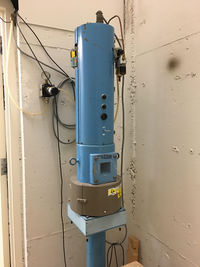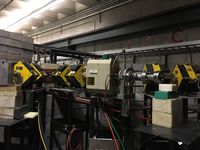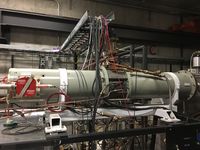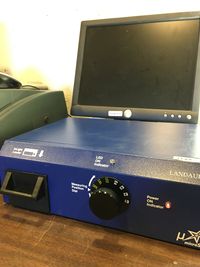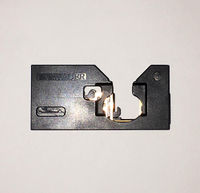Difference between revisions of "CH Thesis Revision 1"
| Line 5: | Line 5: | ||
=Theory= | =Theory= | ||
| − | =Apparatus= | + | =Experimental Apparatus= |
| + | |||
| − | |||
==Cesium Source== | ==Cesium Source== | ||
| Line 110: | Line 110: | ||
\caption{Calculated dose from the OSLs irradiated in the electron beam. Each square corresponds to the physical size and location of each OSL irradiated.} | \caption{Calculated dose from the OSLs irradiated in the electron beam. Each square corresponds to the physical size and location of each OSL irradiated.} | ||
\end{figure} | \end{figure} | ||
| − | |||
| − | |||
=Data Analysis= | =Data Analysis= | ||
Revision as of 05:03, 29 June 2018
Introduction
At the Idaho Accelerator Center in Pocatello, Idaho, knowing how much dose is deposited during experiments is important to know due to requests from customers using the accelerator center. This can be achieved by gaining an understanding of how reproducible nanoDot\textsuperscript{tm} Optically Stimulated Luminescence (OSLs) dosimeters. The OSLs can be calibrated by exposing them to a known source, which leads to well understood measurements when in the experimental setting.
Theory
Experimental Apparatus
Cesium Source
A 9.3 Ci \textsuperscript{137}Cs source was used to calibrate the OSLs and gain an understanding of the relationship between PMT counts and exposure. A system of interlocks is used to safely expose the OSLs. There is an acrylic face plate bolted to the front of the pig, at a set distance of 11.2cm. A sample is positioned 30 cm from the faceplate of the source. Once the interlock requirements have been satisfied, the air supply is turned on allowing the shutter to be opened.
Containment unit for the Cs-137 source.
The exposure rate from the source is determined based on the distance (D) from the source, the activity (A) of the source, and a constant ($\Gamma$). The exposure rate for any given distance is calculated in units of Roentgen/hr using the equation
A gamma factor of and activity is used in these calculations. The distance from the faceplate to the surface of the source needs to be taken into account given the inverse squared distance dependency of the exposure rate. The total distance D is then, D = (Distance to faceplate +0.112m).
With the exposure rate found using these known variables, it is possible to find the total exposure given to the OSLs by integrating the exposure rate over the time the OSL was exposed to the source,
It is necessary when working with exposure to be able to convert to the units supplied by the OSL reader as the two quantities are directly related. By the unit conversion of 1.4554 Roentgen = 1 Rad, a relationship between PMT counts and calculated exposure can be determined.
25B Linac
The RF frequency of the IAC's S-Band 25B Linac is 2856 MHz with an energy range of 4 - 25 MeV. With peak currents being easily able to hit 100mA, and pulse widths from 50 ns to 4 $\mu$s, this accelerator is fully capable to operate at the simulated parameters of 8 MeV, 500 ns pulse width, and 50 mA peak current.
(Left) Accelerator gun. (Right) 0 degree port leading to end of beam pipe.
OSL Reader
The MicroStar i reader manufactured by Landauer is used to measure the radiation dose absorbed by the OSL crystal. By inserting an OSL into the reader, the crystal structure is exposed to an LED, and a photomultiplier tube on the opposing side is used to measure the photons luminescing from the crystal.
Front of OSL reader.
OSL Holder
The OSL reader has software capable of calibrating the reader, through which low dose and high dose calibrations are created. These different calibrations give separate calibration factors. To create the calibrations for the software, Landauer supplies pre-dosed OSLs providing five measurements to encompass the device's dynamic range. Due to uncertainty in exposure between dosing and usage, a custom calibration is used to reduce error in succeeding measurements. The OSL reader calculates the dose based on the observed number of PMT counts . The equation used for this calculation is:
Experimental Procedure
Photon Beam
To expose the OSLs to a photon beam, a one inch thick aluminum brick and sweeper magnet were inserted at 50 cm from the end of the beam pipe. The aluminum brick was used as the converter followed by the sweeper magnet to redirect any charged particles away from the photon beam. An array of 17 OSLs was placed at a distance of one meter from the end of the beam pipe and then irradiated. This setup was irradiated twice, with different arrays of OSLs to gather dose per pulse information for the photon beam. Each array was exposed to approximately 52000 pulses at a rep rate of 250Hz.
\begin{figure}[H]
\centering
\includegraphics[width =0.75\textwidth]{Content/Data_Analysis/Sweeper_Brick2.JPG}
\includegraphics[width =0.75\textwidth]{Content/Data_Analysis/Sweeper_Brick.JPG}
\caption{(Top)ooking in the direction of beam travel to see front face of the aluminum brick. (Bottom) Sweeping magnet used to change the direction of travel of all charged particles.}
\label{fig:result}
\end{figure}
(See Appendix A for run plan)
\begin{figure}[H]
\centering
\includegraphics[width =0.9\textwidth]{Content/Data_Analysis/Square_Array_Photons.png}
\caption{Average dose of the two arrays irradiated by the photon beam. Each square corresponds to the physical size and location of each OSL irradiated.}
\label{fig:result}
\end{figure}
Electron Beam
Exposing OSLs to an electron beam is accomplished by placing an OSL in front of the 25B Linac at the IAC. By taping an OSL to a glass plate at 50 cm from end of beam pipe, and using a laser centered on the end of the beam pipe, the OSL can be exposed to electrons on-axis for the beam. This setup is used to gather dose per pulse information.
To discern dose per pulse and reproducibility information from the measurements of the electron beam, the OSLs are subjected to the same beam characteristics through the custom run-plan. These characteristics consist of a beam energy of 8 MeV, pulse width of 500 ns, and a peak current of 50 mA. By varying the number of pulses which impinge upon the OSLs, a pulse versus dose relationship can be established.
Once single OSLs had been irradiated on-axis, a 4 x 4 array of 16 OSLs was inserted and exposed to the electron beam. As the 4 x 4 array did not allow for a symmetric orientation while having an OSL centered on-axis, the future arrays were modified to consist of 17 OSLs. This modification created more data points for the on-axis dose per pulse measurements. The OSLs were measured before and after irradiation to see how much dose was deposited.
\begin{figure}[H]
\centering
\includegraphics[width =0.5\textwidth, angle=90]{Content/Data_Analysis/16_OSL_Array.JPG}
\includegraphics[width =0.65\textwidth]{Content/Data_Analysis/17_OSL_Array.JPG}
\caption{(Left) Array of 16 OSLs mounted for irradiation. (Right) Array of 17 OSLs mounted for irradiation.}
\label{fig:result}
\end{figure}
\begin{figure}[H]
\centering
\includegraphics[width =0.9\textwidth]{Content/Data_Analysis/Electron_Array3_Thesis_Image.png}
\caption{Calculated dose from the OSLs irradiated in the electron beam. Each square corresponds to the physical size and location of each OSL irradiated.}
\end{figure}
Data Analysis
\chapter{Data Analysis}
\section{nanoDot\textsuperscript{tm} OSL Calibration}
%The Microstar reader used to analyze the OSLs produces a numeric quantity in units of milliRad (mRad) for the total accumulated dose by reading the PMT counts, which is then input into eq.1 along with the OSL sensitivity and calibration factor. The response of the nanoDot\textsuperscript{tm} OSLs to electrons and photons can be quantified in terms of dose using a calibration. Initial attempts to calibrate the OSLs were to follow the manufacturers guidelines, through which two different calibrations are created; a high dose, and a low dose. The low dose calibration is used by the OSL reader when the measured dose is less than 10000 mRad, and the high dose is used for any values exceeding 10000 mRad. These calibrations are created by reading in pre-dosed OSLs provided by Landauer so the OSL reader software can create a linear fit between PMT counts and dose. Using these calibrations assumes that the pre-dosed OSLs have not been subjected to any other exposure during the shipping and storing before use. It was this assumption that led to the creation of a custom calibration using a Cs-137 source. Using a source of known activity allows for calculated exposure rates and a well understood calibration as there is less uncertainty in the dose on the OSL.
By subjecting the OSLs to a known total exposure, it is possible to eliminate the effect of any unknown factors that could have invalidated the listed dose on the pre-dosed OSLs supplied by Landauer. Therefore to establish the relationship between background subtracted PMT counts and total exposure for the OSLs, a custom calibration was needed. This calibration is used in lieu of the calibration given by the OSL reader.
To begin the calibration, a set of fifteen previously unexposed OSLs is chosen at random and exposed to the 9.3Ci Cesium-137 source. \begin{figure}[H]
\centering
\includegraphics[width =0.9\textwidth]{Content/Apparatus/LowDose.png}
% \includegraphics[width =0.6\textwidth]{Content/Apparatus/HighDose.png}
\caption{Low Dose Calibration.}
\label{fig:result}
\end{figure} \newpage \begin{figure}[H]
\centering
% \includegraphics[width =0.6\textwidth]{Content/Apparatus/LowDose.png}
\includegraphics[width =0.9\textwidth]{Content/Apparatus/HighDose.png}
\caption{High Dose Calibration.}
\label{fig:result}
\end{figure}
Multiple OSLs were exposed to the Cs-137 source for the same amount of time and then each was measured by the OSL reader. The PMT counts were recorded and a standard deviation was determined by: \begin{displaymath} \sigma = \sqrt{\frac{\Sigma(x_{i}\ -\ \bar x)^{2}}{n\ -\ 1}} \end{displaymath} Where $x_{i}$ is each PMT measurement and $\bar x$ is the average of the PMT counts and n is the number of OSLs subjected to the same exposure. The standard deviation was used as the uncertainty in the PMT counts for the calibration. The Cs-137 source has a 30.17 yr half life, leading to a static activity during the time of irradiation, as such, no uncertainty can be established in calculated exposure.
With the standard deviations in the PMT counts calculated, the relative error for each calculated exposure can be calculated. The relative percent error is found by \begin{displaymath} Rel. Err.=\frac{\sigma_{PMT}}{PMT\ Average}*100\% \end{displaymath} \begin{figure}[H]
\centering
% \includegraphics[width =0.6\textwidth]{Content/Apparatus/LowDose.png}
\includegraphics[width =0.9\textwidth]{Content/Apparatus/Relative_Error.png}
\caption{High Dose Calibration.}
\label{fig:result}
\end{figure}
\section{Experimental Data}
\subsection{Photon Beam} Once the two OSL arrays had been irradiated by the photon beam, the PMT counts for each OSL were measured. The dose is then calculated by using the high dose calibration in section 4.1. The dose that the OSL absorbs from a photon beam was simulated to be less than that of an electron beam which was then shown experimentally. The OSLs were irradiated with a small number of pulses and then the central OSL was measured. This initial measurement gave a rough calculation of how many pulses the arrays could safely handle without being saturated.
Once all of the irradiated OSLs had been analyzed and dose had been calculated, it was found that the photon beam deposited an average of 10.32 $\pm$ 0.30 mRad per pulse. \begin{figure}[H]
\centering
\includegraphics[width =0.9\textwidth]{Content/Data_Analysis/Contour_Photons.png}
\caption{Contour plot of the average photon dose measurements in Rad.}
\label{fig:result}
\end{figure}
\begin{figure}[H]
\centering
\includegraphics[width =0.9\textwidth]{Content/Data_Analysis/XY_Diagonal_Photons.png}
\caption{X = Y Diagonal Averages of the two photon arrays.}
\label{fig:result}
\end{figure} \begin{figure}[H]
\centering
\includegraphics[width =0.9\textwidth]{Content/Data_Analysis/X-Y_Diagonal_Photons.png}
\caption{X = -Y Diagonal Averages of the two photon arrays.}
\label{fig:result}
\end{figure}
By looking at the diagonals of the arrays, a 7 bin histogram is created. Fitting a gaussian to these histograms gives a rough interpretation of the shape of the beam impinging onto the OSLs.
\newpage \subsection{Electron Beam} Starting with single OSLs positioned on-axis for the electron beam, each was irradiated with two to six pulses. (See run plan for more details) Using the OSL reader, PMT counts for each OSL are measured. The dose can then be calculated using PMT counts and the high dose calibration. Following the reading of the OSLs, the raw data and calculated uncertainties are input into a text file and fed into a data analysis script. This script takes the text file and interprets it into multiple images. As the OSLs are discrete, a square 3 dimensional array is created with +X (beam right) and +Y (beam up) coordinates, along with the dose intensity on the Z axis. To gather information on the shape of the incident beam, two profiles are created along the diagonals of the arrays. \begin{figure}[H]
\centering
\includegraphics[width =0.9\textwidth]{Content/Data_Analysis/Contour_Array3.png}
\caption{}
\label{fig:result}
\end{figure} \newpage \begin{figure}[H]
\centering
\includegraphics[width =0.9\textwidth]{Content/Data_Analysis/XYDiagonal_Array_3.png}
\caption{X = Y Diagonal. Shows a discrete shaping of the beam with a gaussian fit.}
\label{fig:result}
\end{figure} \begin{figure}[H]
\centering
\includegraphics[width =0.9\textwidth]{Content/Data_Analysis/X-YDiagonal_Array_3.png}
\caption{X = -Y Diagonal. Shows a discrete shaping of the beam with a gaussian fit.}
\label{fig:result}
\end{figure}
After irradiation, the OSLs were analyzed using the OSL reader. The measured PMT Counts were used to calculate the average dose per pulse through the high dose calibration. The mean dose per pulse for the electron beam study is 213.87 $\pm$ 3.06 Rad. The dose for each PMT measurement was calculated via the fit for the high dose calibration. \begin{displaymath} Dose = [(slope)(PMT\ Counts) + Y_{int}] \pm \sigma_{i} \end{displaymath} \begin{figure}[H]
\centering
\includegraphics[width =0.9\textwidth]{Content/Data_Analysis/Pulse_v_Dose_Fit.png}
\caption{Linear fit of number of pulses vs calculated dose for all electron beam on axis OSLs.}
\label{fig:result}
\end{figure}
\subsection{Experimental Uncertainty}
Any measured dose in this experiment has an uncertainty that is propagated through from the high dose calibration. All of the doses were calculated directly from the measured PMT counts and then input into the following: \begin{displaymath} Dose = [(slope)(PMT\ counts) + Y_{int}] \pm \sqrt{(\sigma_{slope}(PMT\ counts))^{2}+(\sigma_{Y_{int}})^{2}} \end{displaymath} Following these calculations, the average dose per pulse can be calculated through \begin{displaymath} \frac{Dose}{Pulse}=\frac{\Sigma{Dose_{i}} \pm \sqrt{\Sigma\ \sigma_{i}^{2}}}{Total\ Pulses} \end{displaymath} Where the $\sigma_{i}$ is the uncertainty in the dose and $dose_{i}$ is the dose calculation with no sigma.
With the standard deviation calculated for each individual measurement, the relative percent error is found with the same formula as in section 3.4, except with PMT counts replaced with dose. \begin{displaymath} Rel.\ Err. = \frac{\sigma_{dose}}{Dose\ Average}*100\% \end{displaymath} The calculations for the relative errors yield 4.12\% for each measurement. This relative error shows that the dose can be known within $\pm$4.12\%. The result of 4.12\% is also consistent with the relative error average for the calibration measurements shown in figure 37.
%\newpage
%\begin{displaymath}
%([norm]/(2.*3.1415*[xsigma]*[ysigma]*sqrt(1 - [p]**2)))*2.718**(-((x - [xbar])**2/[xsigma]**2 + (y - [ybar])**2/[ysigma]**2 - (2*(x - [xbar])*(y - [ybar])*[p])/([xsigma]*[ysigma]))/(2.*(1 - [p]**2)))
%\end{displaymath}
%\newpage
%A run plan is created to measure the dose per pulse of the 25b Linac. As the OSLs have a maximum operating point at 1500 Rad, it was decided to keep the dose in the middle of the operating range. With the listed beam characteristics, six unattenuated pulses is the maximum possible to subject the OSLs to without saturating the OSLs.
%The point of the electrons was to find dose/pulse information on-axis of the accelerator to help find total dose for quartz. This information was then used to irradiate some quartz and ABS plastic samples to a known dose, to allow for rad hard tests. Along with structural integrity tests in the plastic. (transparency in quartz).
%Once the initial singles and arrays of OSLs had been dosed by the electron beam, a one inch thick Aluminum brick was placed at the end of the beam pipe. Further down the beam line, a sweeping magnet was inserted to redirected all charged particles away from the next set of OSLs. Using the aluminum brick as a converter and beam stop, a photon beam was formed.
Conclusion
\chapter{Conclusion} The calibration is key in understanding the response of the OSLs to a wide range of doses. Without being certain of the exposure the calibration OSLs have been subjected to, there can be some unknown uncertainty in the calibration. By quantifying this uncertainty, any succeeding measurements are better understood.
Calculating the experimental uncertainty and propagating the uncertainty through from the high dose calibration led to the result that the OSLs are reproducible in the range of 460-1440 Rad to $\pm$4.12\%. To follow this result, the mean dose for the on-axis electron beam 213.87 Rad $\pm$1.43\%.
Appendix
\chapter{Appendix}
\section{GEANT4 Macro} /gps/particle e-
/gps/pos/type Beam
/gps/pos/rot1 1 0 0
/gps/pos/rot2 0 1 0
/gps/pos/shape Circle
/gps/pos/centre 0 0 -91 cm
/gps/pos/sigma r 0.9652 cm
/gps/ang/rot1 0 1 0
/gps/ang/rot2 1 0 0
/gps/ang/type beam1d
/gps/ang/sigma r 0.756. deg
/gps/energy 8 MeV
/run/beamOn 1560550
\section{Run Plan} \begin{center}
\resizebox{5.3in}{!}
{
\begin{tabular}{| c | c | c | c | c | c | c | }
\hline
Shot Number & Number of Pulses & Number of OSLs & Dose (Rad) (0,0) & Dose/pulse (Rad) (0,0) & Al Brick with W Converter \\ \hline
1 & 6 & 1 & 768.10344 & 128.017 & Out \\ \hline
2 & 6 & 1 & 795.26442 & 132.54407 & Out \\ \hline
3 & 6 & 16 & Off Center & Off Center & Out \\ \hline
4 & 6 & 17 & 592.89645 & 98.816075 & Out \\ \hline
5 & 6 & 1 & 1435.75504 & 239.292 & Out \\ \hline
6 & 2 & 1 & 468.28238 & 234.14119 & Out \\ \hline
7 & 4 & 1 & 842.87814 & 210.719535 & Out \\ \hline
8 & 5 & 1 & 1062.99342 & 212.598684 & Out\\ \hline
9 & 6 & 1 & 646.63748 & 215.5458267 & Out\\ \hline
10 & 4 & 17 & 796.48564 & 199.12141 & Out\\ \hline
11 & 51948 & 17 & 531.9275 & .01023961461 & In\\ \hline
12 & 52106 & 17 & 541.85896 & .01039916631 & In\\ \hline
13 & 4 & 1 & 771.12338 & 192.780845 & Out\\ \hline
14 & 4 & 1 & 841.583 & 210.39575 & Out\\ \hline
15 & 4 & 1 & 832.54936 & 208.13734 & Out\\ \hline
\hline
\end{tabular}
}
\end{center}
\section{Calibration Data}
put laundauer and custom calibration tables here
\section{OSL Reader Instructions} The OSL reader is a blue box of dimensions 32.75cm x 23.25cm x 10.5cm. On the left side of the front face is the drawer in which an OSL in a holder is inserted. Once the drawer is shut, the black knob on the front is turned from H/P to E1, opening the OSL and exposing the crystal to an LED.
